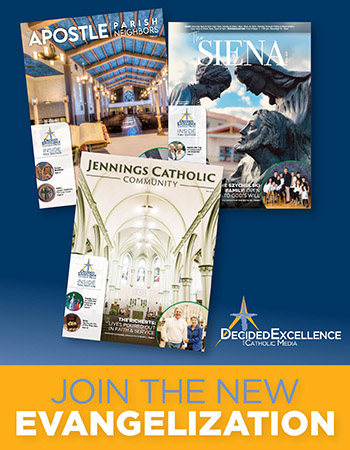Encouraging the faith requires a heart of tireless joy. Only with a joyful faith can one battle doubts and divisions without exhaustion: for even dealing with the doubts of others and their charges against the Church can wear one down, just as staring into a deadened fog dulls one’s eyes without making them blind. There is a certain witticism of G. K. Chesterton often quoted by the sort of people who like to gather around and quote Chesterton. It comes from an essay titled “On Running After One’s Hat,” and it runs: “An adventure is only an inconvenience rightly considered. An inconvenience is only an adventure wrongly considered.” What is the right consideration of frustration or dissension or fearful opposition to what faith holds? Chesterton offers such a perspective in his excellent book The Everlasting Man (a sort of ecclesial anthropology that doubles as a summary history of the Church), in the chapter called “The Witness of the Heretics.” His whole argument will not fit here. I will briefly touch one salient point, but one would only benefit from a closer read of the chapter itself, if not the whole book. An hour spent on his rhetoric alone would not be lost.
Chesterton argues that the inevitably reductionist caricatures of the Church and her teaching which her opponents make can round out one’s appreciation of the Church’s real nature. He begins with a meditation on the aptness of the scriptural metaphor of the key Christ gives Peter. The Church is like a key, he says, in three ways: first, it is primarily a shape, the virtue of which comes precisely in its being a particular, inflexible shape. Second, it is (to use Chesterton’s word) a fantastic shape, rather more like the flailing arms of a great tree than the regular roundness of a stone. Thirdly, far from being a mere polygon, it is such that one might suppose it was shaped in response to something, or in accord with some design. It is the key that fits. If, in other words, the Church is a rather complex solution, it is because it was given in response to the rather complex problem of human sin.
Chesterton’s brilliance, however, is not in validating the metaphor of the key, but finding in it a program for defending the Church in one’s own heart—something much needed today for the layman, and which he does not easily find lying about. Christianity is a very unusual religion among religions, and it has been charged with a great many defects. Imagine if someone were to criticize a key for having sharp bits sticking out on one side, whereas the other is nice and smooth. Our response to him would largely be the same as to his friend, who, let us say, criticized the key for having one smooth edge rather than two jagged ones. Someone else might say the key has too little symmetry, while another is already protesting that it has too much. On and on the imaginary complaints go pointing out opposite flaws. The one holding the key, however, although he may respond to each individually, would be right to say at large that the key has all these oddities and is set between extremes precisely because it is the right shape. No other shape will open the door.
So it is with the Church. This is the “witness of the heretics.” Through history the Church has variously been called the fad of the weak and yet the offspring of ancient imperialism; too merciful and yet too juridical; stuck in its outdated ways and yet subject to sudden and arbitrary changes; debauched and yet unbearably prudish. In Chesterton’s vivid imagination, whenever some learned man indicts the Church for such and such a flaw, some other heretic rises from the depths of the past and protests that she smacked too much of its opposite. Chesterton cites a number of the most important historical examples in his chapter.
Two lessons can be drawn from this perspective of the Church. First, inasmuch as heresy is by definition in reaction to the truth of faith, it bears an entirely different intellectual and therefore spiritual posture than dogma professed in faith. The latter proceeds from a supernatural virtue, freed for the truth by charity, and the former proceeds from a spirit of pride, choosing to hold some intellectual position rather than bear out the opposite position. Secondly, inasmuch as the Church always contradicts error with surprising speed and vigor, whether from within or without, from the left or the right, she reveals in her alacrity the difference in character between dogma and heresy. Heresy is weary of uncertainty, impatient for knowledge, proud of its powers, intolerant of dogmatic complexity; dogma never tires of discovering and defending the truth. The one is heavy, monotonous, (as history attests) insecure, and divisive; the other is light, dynamic, ever young, and whole. It is the very difference between the living and the dying.
I find that there are generally two kinds of responses to fog, if it is not too much of a generalization to say so. The first sort is the oppressed impatience that people feel when deprived of depth and color, resulting in a strange mix of anxiety and listlessness. The second sort, while not free from the weight of the still, monotonous air, breathes it in all the same with renewed vigor and the excitement of meeting with misadventure. The first response seems generally more common, especially where people are familiar with fog; and not fog alone arouses this insipid frustration, but anything that pesters without a clear or definite solution. Nothing defends the mind from such impotent and yet desolating assaults except abiding joy. Joy alone seems able to consider an inconvenience an adventure, to use Chesterton’s phrase.
There are, admittedly, a number of messes in the Church. Undoubtedly all social and theological difficulties must be faced, and faced with courage. But we must be able to defy illusion without becoming disillusioned; if we become weary, we must not allow ourselves to become wearily convicted; if we doubt, we must nevertheless confess the faith with our whole heart. Without regard to the appearance of victory or defeat in social or theological problems, let us look into the fog with joy.






